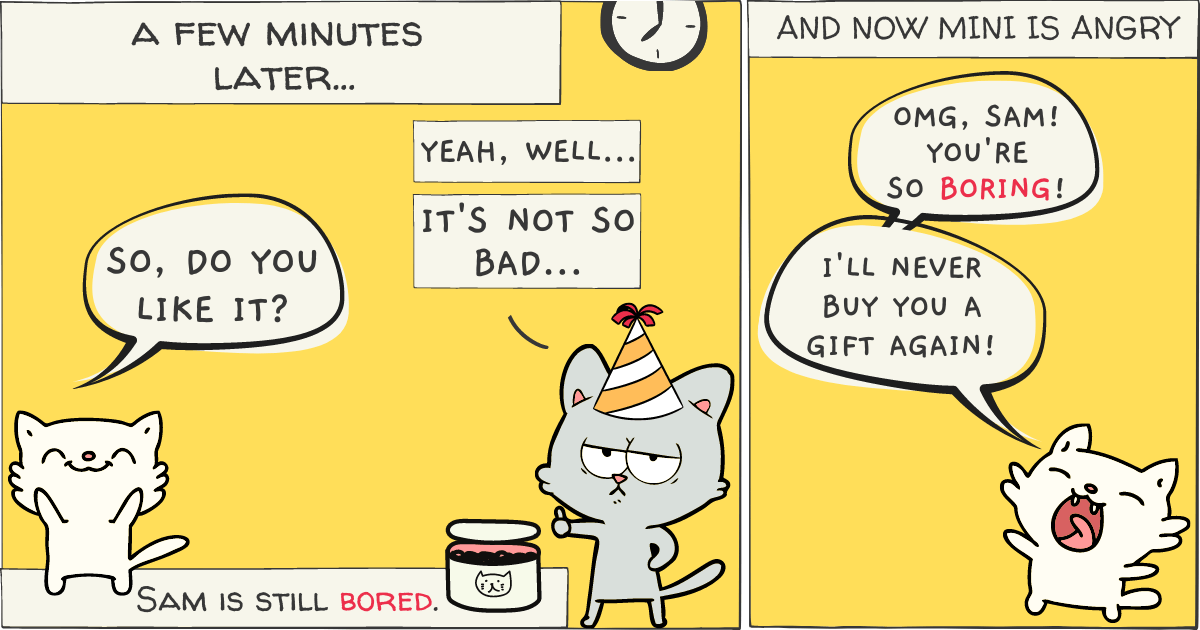The topic of -ed & -ing adjectives is challenging for many new learners of English, and while it is not like you killed someone by telling them – you look boring, instead of, you look bored, it is still a good idea to clear things up once and for all, and not end up in an awkward situation. 😀
Because we start with some general information first, check the Table of Contents below to jump to the point if you are not interested in the rest.
What are adjectives, and why do we need them?
Adjectives are words that describe other words (nouns1, pronouns2, noun phrases3, or gerunds4) by telling us more about them in terms of height, length, size, or some other quality.
Here are some examples:

What a pretty red dress.
The adjectives pretty and red above modify the noun dress. The opinion adjective – pretty – expresses the speaker’s opinion about the dress, while the color adjective – red – tells us what color it is.
- Oh, poor me2!
The adjective poor modifies the pronoun me.
- A large group of people3 gathered at the train station.
The adjective large modifies the noun phrase group of people, and we understand it was a large group of people rather than a small group of people.
- Her beautiful singing4 made people stop and listen.
The adjective beautiful modifies the gerund singing.
How to tell if a word is an adjective?
In general, to determine whether a word is an adjective or not, we could check if it has comparative and superlative forms:

tall, taller, (the) tallest
- big (g*)
- + er = bigger
- + est = (the) biggest
- pretty (y-i*)
- + er = prettier
- + est = (the) prettiest
- exciting
- more + exciting = more exciting
- most + exciting = (the) most exciting
Speaking of comparison, we can say as tall as, as pretty as. We do not say as chair as or as table as, etc.
Also, we say very tall, more beautiful, much smaller. We do not say very table, more chair, much garden.
Some examples:
- kitchen table
- passenger seat
- cupboard door
Very often, adjectives of purpose end in -ing:
- shopping bag
- frying pan
- rolling pin
Where do adjectives go in a sentence?
Adjectives can be placed differently in a sentence. If we use a linking verb (for example, to be) or a sense verb that acts as a linking verb (to look, to feel, to sound, to seem, to appear, to taste, to smell, etc.), adjectives go after the verb (and word they describe). Such adjectives are also called predictive adjectives1.
- The table is white1.
- The story sounds interesting1.
In case there is no verb that links the adjective and the noun, the adjective goes before the noun it describes. These adjectives are called attributive adjectives2.
- My neighbors live in a big2 house.
- They have a beautiful2, large2 garden, and three small2 dogs.
Most adjectives come before or after the words they describe.

This cat is cute. The cute cat is sleeping.
However, some adjectives can only function predicatively, i.e. they need a linking or a sense verb. For example:
- afraid
- alone
- asleep
- awake
*The list goes on.
- The cat is afraid/ awake/ asleep. ✅
- The afraid/ awake/ asleep cat. ❌
Order of adjectives (when more than one in a sentence)
It’s possible to have two or more adjectives before another word in a sentence to describe it even further. In that case, the adjectives come in a specific order.
In brief, when using more than one adjective in a sentence, usually, adjectives of opinion1 come first. The size2, shape3, age5, color6, material9, etc. (also called “fact adjectives”) follow.
- I love my new5, red6 sweater.
- I have a big2, round3 carpet in the kitchen.
Formation of adjectives
Some adjectives are formed by adding either a prefix to the beginning of another word (it could be a noun, a verb, or another adjective) or by adding a suffix to the end.*
In some cases, if an adjective is formed by adding a prefix to another adjective, the meaning becomes the opposite.
- un + fair = unfair (the opposite of fair)
- im + possible = impossible (the opposite of possible)
- child + ish = childish (acting or behaving like a child)
- beauty + ful*(y-i) = beautiful (pretty)
To the point: -ed, and -ing adjectives
Usually, adjectives that end in -(e)d or -ing are formed by adding these endings to verbs. As they are formed differently, they mean different things.
- verb + ed = -ed adjective
- verb + ing = -ing adjective
If the word that the endings are attached to ends in E, first E goes away, and then we add the endings.
- to excite + ed = excit + ed = excited* (and not exciteed!)
- to excite + ing = excit + ing = exciting* (and not exciteing!)
Is there a difference in the meaning of -ed and -ing adjectives, and what is it?
Look at Sam and Mini’s story and see if we can find the difference.



We use adjectives that end in -ed to explain how we or somebody else feels.
- Sam is not very happy. He is very bored.
We use adjectives that end in -ing to explain the effect something or somebody else has on us or what we think about someone or something.
- OMG. Sam! You’re so boring! I’ll never buy you a gift again!
Important examples
The comparison between bored and boring is probably the most popular way to illustrate the difference between -ed and -ing adjectives. There are, however, some other examples that are important and should be mentioned as well.
Interested vs. interesting
Things and people can be interesting but things cannot be interested.
- This book is interesting. ✅
- This book is interested. ❌
- I am interested in learning new languages. ✅
- I am interesting in learning new languages. ❌
- She has an interesting idea. ✅
- She has an interested idea. ❌
Surprised vs. surprising
People can be surprised but things cannot.
- The gift was surprising. ✅
- The gift was surprised. ❌
- I am surprised to see you here. ✅
- I am surprising to see you here. ❌
Confused vs. confusing
Things cannot be confused. People can be, and often are confused. People can find things, as well as other people confusing at times. 🤓
- I am confused by the instructions. ✅
- I am confusing by the instructions. ❌
- The instructions are confusing. ✅
- The instructions are confused. ❌
- He is confused about which bus to take to the city center. ✅
- He is confusing about which bus to take to the city center. ❌
Tired vs. tiring
- She is tired. ✅
- She is tiring. ❌
- Cleaning the house can be tiring. ✅
- Cleaning the house can be tired. ❌
Annoying vs. annoyed
Things and people can be both annoyed and annoying, but things cannot be annoyed.
- The loud music is very annoying. ✅
- The loud music is very annoyed. ❌
Final thoughts
While people (and cats 🤗) can be both bored and boring, confused and confusing, annoyed and annoying – things can only be boring, confusing, annoying, etc.
Things, whatever they are – a birthday, a TV show, a trip, a job – can never be bored, tired, or confused because they don’t have feelings.
So, things are always -ing, and the rest of us can be both -ed, and -ing! Isn’t that exciting? 🤩



